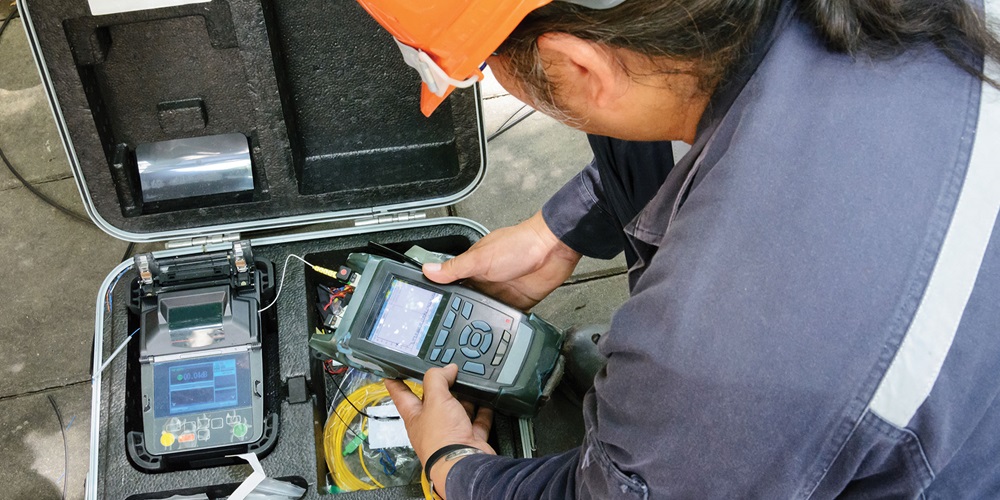High-quality ofda solutions deliver precise fibre testing and consistent results.
Wiki Article
Unveiling the Secret Utilizes of Optical Fiber Evaluating for Efficient Data Transmission
In the realm of modern communication, optical fibre testing emerges as a crucial practice for optimizing data transmission. By employing approaches such as Optical Time Domain Reflectometry (OTDR) and insertion loss assessments, network operators can effectively pinpoint and address issues that may compromise signal stability. As the demand for faster and much more trusted links proceeds to climb, the effects of these screening strategies prolong beyond immediate fault discovery, affecting long-lasting network performance. Understanding the multifaceted applications of optical fiber screening invites a deeper expedition into its critical role in forming the future of information communication.
Value of Optical Fiber Testing
The importance of optical fibre testing can not be overemphasized, as it works as a critical part in making sure the reliability and performance of data transmission systems. In a period where high-speed communication is vital, any shortages in fibre optics can cause significant data loss and decreased performance. Strenuous testing methods are vital to confirm the stability and efficiency of optical cable televisions.Examining allows for the identification of problems such as micro-bends, macrobends, and splice losses that could impede signal high quality. It gives insights into the overall attenuation and bandwidth abilities of the fibre, ensuring that the network meets particular operational standards. Regular testing not just boosts system efficiency however likewise prolongs the life-span of the framework by recognizing potential problems before they intensify into costly failures.

Kinds of Optical Fiber Tests
Different types of optical fibre tests are conducted to ensure the performance and integrity of fibre optic networks. These tests can be classified into numerous vital types, each offering a details function in evaluating the honesty of the fibre.First, Optical Time Domain Reflectometry (OTDR) is a prominent test that identifies faults, splices, and connectors within the fibre. By sending out pulses of light and evaluating the mirrored signals, service technicians can identify concerns along the fiber's size.
Second, insertion loss examinations evaluate the amount of signal loss when light travel through adapters or splices, which is crucial for maintaining network efficiency.
Third, return loss tests gauge the quantity of light showed back towards the source, supplying insights into the quality of links and potential sources of interference.
In addition, continuity examinations make certain that the fibre path is full, permitting specialists to verify that the fiber is undamaged without any breaks. fibre testing equipment.
Finally, visual fault locators utilize noticeable light to recognize breaks or serious bends in the fiber, aiding in fast troubleshooting. Jointly, these tests create a detailed approach to keeping optimal efficiency in fibre optic networks.

Applications in Network Upkeep
In modern telecommunications, effective network upkeep relies greatly on optical fibre testing to determine and fix issues quickly. Routine testing makes sure that the network runs at ideal efficiency levels, lowering downtime and boosting user experience.One of the primary applications of optical fiber testing in maintenance is the discovery of mistakes, such as breaks, bends, or inappropriate connections. Strategies like Optical Time Domain Name Reflectometry (OTDR) permit technicians to situate these issues accurately and assess the high quality of the fibre web link. Furthermore, loss testing verifies the honesty of the optical path, making sure that signal depletion remains within acceptable limits.
Regular upkeep screening also aids in safety nets, identifying potential issues prior to they escalate into significant failures. This aggressive strategy can save organizations both time and funds. In addition, throughout upgrades or growths, optical fibre screening guarantees that brand-new installations incorporate perfectly with existing infrastructure.
Enhancing Data Transmission Integrity
Effective network upkeep with optical fibre testing not only addresses prompt problems however additionally plays a significant function in boosting data transmission dependability. By determining mistakes, measuring signal loss, and analyzing the general condition of fibre optic cable televisions, screening ensures that potential troubles are rectified before they rise into significant disruptions.Routine optical fibre screening, such as time-domain reflectometry (TDR) and optical time-domain reflectometry (OTDR), permits specialists to determine the precise areas of breaks, flexes, or connector problems within the network. This aggressive technique not only reduces downtime however additionally optimizes the performance of information transmission by making certain that the pathways for signals are clear and functioning effectively.
Moreover, testing help in validating adherence to industry criteria and specs, which is crucial for preserving the stability of information circulation. By making certain that each connection meets needed limits for loss and high quality, organizations can reinforce their confidence in the integrity of their data networks.
Inevitably, buying comprehensive optical fibre testing not only improves information transmission integrity but also sustains the long-lasting functional effectiveness of communication frameworks.
Future Patterns in Fibre Testing
Emerging innovations are poised to change fibre screening, leading the method for boosted performance and accuracy in information transmission diagnostics (robotic vision). As the need for faster web and higher transmission capacity remains to rise, the combination robotic vision of sophisticated devices such as expert system (AI) and artificial intelligence (ML) is set to change standard fibre screening techniques. These modern technologies will certainly allow predictive upkeep and automated fault discovery, dramatically reducing downtime and improving network integrityAdditionally, the adoption of Internet of Points (IoT) devices will facilitate real-time surveillance of fiber networks, enabling for immediate identification of efficiency issues. This shift in the direction of aggressive administration will decrease disruptions and optimize data circulation.
Moreover, technologies in optical time-domain reflectometry (OTDR) and new testing requirements will improve the accuracy of measurements, guaranteeing that information stability is maintained throughout the transmission procedure. The introduction of 5G modern technology likewise requires the advancement of much more advanced fibre testing strategies to support its high-speed requirements.
Final Thought
In verdict, optical fiber screening is necessary for preserving effective information transmission within communication networks. Regular screening not only ensures compliance with industry criteria yet likewise promotes proactive maintenance, eventually contributing to the lasting integrity and efficiency of fibre optic systems.Report this wiki page